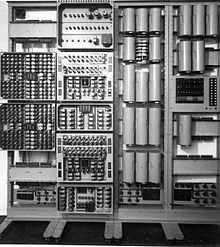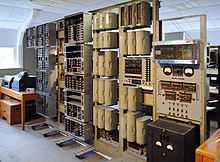Harwell computer

The Harwell computer, later known as the Wolverhampton Instrument for Teaching Computing from Harwell (WITCH),[1] or the Harwell Dekatron Computer,[2][3] was an early British relay-based computer. From 2009 to 2012, it was restored at the National Museum of Computing,[4] where it is described as "the oldest original functioning electronic stored program computer in the world".[5] The museum hopes to use the computer's visual, dekatron-based memory to teach schoolchildren about computers.[4]
Construction and use at Harwell
The computer, which weighs two and a half tons[6] was built and used at the Atomic Energy Research Establishment in Harwell, Oxfordshire.[7] Construction started in 1949, and the machine became operational in April 1951. It was handed over to the computing group in May 1952 and remained in use until 1957.[8]
It used dekatrons for volatile memory, similar to RAM in a modern computer, and paper tape for input and program storage.[9] Output was to either a Friden teleprinter or to a paper tape punch.[8] The machine was decimal and initially had twenty 8-digit dekatron registers for internal storage, which was increased to 40 which appeared to be enough for nearly all calculations. It was assembled from components more commonly found in a British telephone exchange.[10] The man who led the effort to rebuild the machine (see below) put it in perspective to the BBC: "All together, the machine can store 90 numbers. The closest analogy is a man with a pocket calculator," Delwyn Holroyd, who led the restoration effort, tells the BBC in a video about the restoration.[6] Although it could on occasions act as a true stored-program computer, that was not its normal mode of operation. It had a multiplication time of between 5 and 10 seconds, very slow for an electronic computer.[11]
As Cooke-Yarborough wrote of his design in 1953 "a slow computer can only justify its existence if it is capable of running for long periods unattended and the time spent performing useful computations is a large proportion of the total time available". The design was noted for its reliability because in the period from May 1952 until February 1953 it averaged 80 hours per week running time. Dr Jack Howlett, Director of the Computer Laboratory at AERE 1948–61, said it "could be left unattended for long periods; I think the record was over one Christmas-New Year holiday when it was all by itself, with miles of input data on punched tape to keep it happy, for at least ten days and was still ticking away when we came back."[2] It was the machine's untiring durability, rather than its speed, that was its main feature. Human mathematicians (a job role called a "hand-computer") could make calculations at a similar speed, but not continuously for the same lengths of time. Dr Howlett commented:
One day EB ‘Bart’ Fossey, an excellent hand-computer (still with what used to be called the Atlas Computer Laboratory), settled down beside the machine with his desk machine and attempted a race. He kept level for about half an hour working flat out, but had to retire, exhausted; the machine just ploughed on.[2]
Subsequent use, renaming as the WITCH and disuse

In 1957, at the end of its life at Harwell, the Oxford Mathematical Institute ran a competition to award it to the college that could produce the best case for its future use.[8] The competition was the idea of John Hammersley, who had worked at AERE previously. The competition was won by the Wolverhampton and Staffordshire Technical College (which later became Wolverhampton University) where it was used to teach computing until 1973.[8] The computer was renamed as the WITCH, the Wolverhampton Instrument for Teaching Computing from Harwell.[8]
The WITCH was donated to the Museum of Science and Industry, Birmingham in 1973. After the museum closed in 1997, the computer was disassembled and stored at the Birmingham City Council Museums Collection Centre.[3][12]
Restoration
From September 2009, the machine was loaned to The National Museum of Computing at Bletchley Park, where it began to be restored to working order as a Computer Conservation Society project.[5][13] The museum, a registered charity, invited members of the public and industry to sponsor the restoration of the Harwell computer by purchasing one of 25 shares at £ 4 500 each.[5] In 2012, the restoration was completed successfully.[4]
A short book has been produced about the machine and the restoration project. It also includes a brief technical description of the machine. It is available from the museum and also from Amazon (See below).
See also
- List of vacuum tube computers
- Category:Electro-mechanical computers
References
- ↑ Cooke-Yarborough, EH (March 1953). "NPL Symposium on Automatic Digital Computation" (JPEG) (image). Retrieved 9 January 2009.
- ↑ 2.0 2.1 2.2 Howlett, John ‘Jack’ (1979). "Computing at Harwell: 25 years of Theoretical Physics at Harwell: 1954–1979". Retrieved 30 May 2009.
- ↑ 3.0 3.1 Kirby, John ‘Jack’ (3 September 2007). "From Thinktank, Birmingham Museums about the WITCH Harwell Dekatron Computer" (email). Andrew Oakley. Retrieved 8 January 2009.
- ↑ 4.0 4.1 4.2 Ward, Michael ‘Mike’ (19 November 2012). "Technology Correspondent". News (UK: BBC). Retrieved 20 November 2012.
- ↑ 5.0 5.1 5.2 Fleming, Stephen (3 September 2009). "Challenge begins to exhibit the world’s oldest, working computer". The National Museum of Computing. Retrieved 3 September 2009.
- ↑ 6.0 6.1 61-year-old computer springs back to life, CNN.com, Wednesday, November 21, 2012
- ↑ "Computing at Harwell" (report). UK: Chilton computing. Retrieved 7 December 2008.
- ↑ 8.0 8.1 8.2 8.3 8.4 Murrell, Kevin (August 2008). "The Harwell Computer, better known as The 'WITCH' Computer". Computer Conservation Society. Retrieved 25 November 2008.
- ↑ "Atomic Energy Authority (UK)". The Museum. Old computers. Retrieved 25 November 2008.
- ↑ "History of SCIT Computers". University of Wolverhampton School of Computing and Information Technology. Retrieved 2008-11-25.
- ↑ Lavington, Simon (1980). Early British Computers. Manchester University Press. p. 139. ISBN 0-7190-0803-4.
- ↑ Bimingham, UK.
- ↑ "Reboot for UK's 'oldest' computer". News. UK: BBC. 3 September 2009. Retrieved 3 September 2009.
External links
| Wikimedia Commons has media related to Harwell computer. |
- "Britain’s Oldest Working Computer Roars to Life", Wired, September 2009.
- "UK's 'oldest' computer rebuilt", News (UK: BBC).
- "Witch at Bletchley: 'World's oldest working digital computer'", News (UK: BBC).
- Witch, Computer Conservation Society.
- "Harwell dekatron Witch restoration during 2 012", Current projects, The National Museum of Computing.
- New Book: "The Harwell Dekatron Computer", The National Museum of Computing.